Birth Home of Queen Jeongsun (정순왕후생가)
14.5 Km 26382 2024-02-22
39 Handari-gil, Eumam-myeon, Seosan-si, Chungcheongnam-do
Birth Home of Queen Jeongsun is the house where Queen Jeongsun (1745-1805), the queen consort of King Yeongjo (1694-1776), the 21st monarch of the Joseon dynasty (1392-1897), lived until she became queen in 1759. It is estimated to have been built in the 17th century and features the architectural characteristics of hanok, with its distinctive "ㅁ" shape and tiled roof.
Gyeam House
14.5 Km 8410 2021-04-09
45, Handari-gil, Eumam-myeon, Seosan-si, Chungcheongnam-do
+82-41-688-1182, +82-10-2376-8273, +82-10-3045-8273
The House of Kim Gi-hyeon (Gyeam Historic House, National Folklore Cultural Heritage 199) is a hanok with over 100 years of history that was established by renovating a nobleman’s house dating from the nineteenth century and equipping it with modern facilities. The Gyeongju Kim clan has lived in the Seosan area, a fertile stretch of land in the middle of the west coast region, for over 600 years. The house has been open to the public since 2010, and attracts many Korean and foreign guests.
The owner renovated the old house by installing a modern bathroom, sink, kitchen and air-conditioning and filling it with antique furniture, and transformed it into a clean and pleasant tourist accommodation with high-class bedding in order to avoid the stereotype about hanok being uncomfortable. In particular, the kitchen has been transformed into a modern facility where guests can enjoy a cup of tea or a meal. The house is also packed with charming features including a small old well equipped with a pump, a wood-burning stove with an iron pot, and a platform for crocks of sauces and condiments.
The House of Kim Gi-hyeon is home to the small Wadang (Roof Tile) Museum, which contains a collection of roof tiles ranging from the Goryeo Dynasty to the Joseon Dynasty. The friendly owners also run a ‘Wadang Rubbing Experience’ program that is popular among foreign tourists and students alike, and strive to provide all their guests with comfort and relaxation and share pleasant moments with them.
The house’s courtyard reflects the beauty of each season, including flower blossoms in spring, colorful leaves in autumn, and a snowy landscape in winter.
Gwangcheon Cave Salted Shrimp Market (광천 토굴새우젓시장)
14.7 Km 23897 2024-02-26
8-20, Gwangcheon-ro 285beon-gil, Gwangcheon-eup, Hongseong-gun, Chungcheongnam-do
Gwangcheon Cave Salted Shrimp Market is a traditional market located in Gwangcheon, between Hongseong and Boryeong. Gwangcheon’s proximity to the Yellow Sea makes it a famous place for jeotgal (salted seafood), made using seafood and shrimp caught from the Yellow Sea, and laver seaweed. Gwangcheon’s saeujeot (salted shrimp) is stored and aged in a cave tunnel, so it has great quality. The market also offers agricultural goods, seafood, clothing, and sundry items.
Bongsusan Recreational Forest (봉수산 자연휴양림)
15.5 Km 21081 2014-12-20
153, Imjonseong-gil, Daeheung-myeon, Yesan-gun, Chungcheongnam-do
+82-41-339-8936~8
Opened in 2007, the Bongsusan Mountain Natural Recreation Forest offers a variety of forest recreation facilities. The area is home to various wild birds. The forest also offers various hiking trails, which take between one and three hours to complete. The slopes are relatively gentle. Various rest and forest bathing sites are setup throughout the forest. The Yedang Reservoir is nearby, which is the nation’s top fishing ground. Also in the area is the Hyeongje (Brother) Park, Daeheung Dongheon, Daeryeonsa Temple, Imjonseong Fortress, Deoksan Hot Spring, Sudeoksa Temple, Chunguisa Temple, the residence of Chusa Kim Jung-hee, and the Korea Traditional Architecture Museum.
Rock-carved Buddha Triad in Yonghyeon-ri, Seosan (서산 용현리 마애여래삼존상)
15.6 Km 37513 2020-03-27
65-13, Maaesamjonbul-gil, Seosan-si, Chungcheongnam-do
+82-41-660-2538
Seosan Maaesamjonbul (Rock-Carved Buddha Triad) is carved into a huge rock
cliff at the entrance to Bowonsa Temple at Gayasan Mountain. The Rock-Carved
Buddha was discovered in 1958, and is considered the oldest and one of the most
outstanding Buddha rock carvings in Korea.
Standing Buddha stands in
the center, the cross-legged Buddha is to the right, and Standing Bodhisattva
is on the left. The main Buddha, Yearaeipsang (Standing Buddha) is 2.8m high.
All sculptures carved in the middle of Baekje (6th century) are called
"Baekje's Smile," named for their trademark bright smiles. The appearance
of the smile changes depending on the direction of the sunlight, so these statues
were designated as National Treasure No. 84. The best time to see the smile
is from 9-11 a.m.
The location, an important site along a key transportation
route from China to Baekje, is on the way to Buyeo from the Taean peninsula.
The masterful work represents the active interchange of culture with China during
that time period.
Daeheung Dongheon (대흥동헌)
16.0 Km 3953 2021-05-25
33, Uijoeunhyeongje-gil, Yesan-gun, Chungcheongnam-do
+82-41-339-7332
"Dongheon" refers to the administrative building or headquarters for the top city official of the Joseon dynasty. This tile-roofed house measures six kan (traditional Korean measuring unit), or approximately 14.4 meters, on the front, two kan (4.8 meters) on the side and is 3.3 meters in x_height. Records carved on its gate show that the wooden house was constructed in 1407. The house, which is characteristic of late Joseon dynasty architecture, was once used as Daeheung-myeon office, but was dismantled and restored to its original appearance in 1979.
Hongseong Namdanghang Port Jumbo Shrimp Festival (홍성 남당항 대하축제)
16.2 Km 26270 2022-11-11
213-1, Namdanghang-ro, Hongseong-gun, Chungcheongnam-do
• 1330 Travel Hotline: +82-2-1330 (Korean, English, Japanese, Chinese) • For more info: +82-10-3288-9551
Namdanghang Port, located at the west end of Hongseong, is a famous west coast port known for its exceptional seafood. Surrounded by the clean waters of Cheonsuman Bay, Namdahang Port is home to a wide array of sea life including blue crab, cockle and webfoot octopus. Namdanghang Port also draws throngs of visitors from early September to mid-October every year for the country’s largest Jumbo Shrimp Festival.
Hongseong Namdang Port Saejogae Festival (홍성남당항 새조개축제)
16.2 Km 89385 2024-01-24
1-1 Namdanghang-ro 213beon-gil, Seobu-myeon, Hongseong-gun, Chungcheongnam-do
+82-41-634-0104
Hongseong Namdang Port Saejogae Festival celebrates the saejogae (egg cockle) that is harvested around Namdang Port and Cheonsuman Bay between December and April of every year. The plump saejogae are famous for their chewy texture and nutritional value, full of protein, iron, and other essential minerals.
Hongseong Namdang Port Sea Trout Festival (홍성남당항 바다송어 페스티벌)
16.2 Km 0 2024-05-22
1-1 Namdanghang-ro 213beon-gil, Seobu-myeon, Hongseong-gun, Chungcheongnam-do
+82-41-634-0104
Hongseong Namdang Port Sea Trout Festival celebrates the local spring-time catch of sea trout, a healthy food with a tasty flavor and chewy texture. During the festival, enjoy a range of activities including performances and catching barehanded fishing.
Seosan Munsusa Temple (문수사(서산))
16.3 Km 20688 2020-01-16
201, Munsugol-gil, Seosan-si, Chungcheongnam-do
+82-41-663-3925
The exact founding date of Munsusa Temple is unknown because there are no official records that have been discovered. The temple is estimated to date back to the Goryeo dynasty due to a prayer found in 1973 at the Gilt-bronze Seated Buddha in the temple’s Geungnaksiljeon Hall dated 1346. Around 600 items were discovered along with the prayer, including unbleached ramie cloth, a short-sleeved gown, rice, and barley. Munsunsa has the tranquil atmosphere of a mountain temple. When spring arrives, cherry blossom flowers and wild flowers bloom across the mountain and the nearby cattle farm call to mind a traditional Korean painting.
Munsusa Temple's Geungnaksiljeon Hall is a beautiful building constructed in the Jusimpo style (the column brackets placed only on top of the columns) combined with Dapo style (the column brackets placed between columns as well as on top of the columns). It is designated as Chungcheongnam-do Tangible Cultural Property No. 13. Inside the gorgeously and majestically carved hall are many relics including Gilt-bronze Seated Buddha, Samsebulsang statues (statues of Buddhas of Three Times (past, present and future)), Nahansang statues (statues of disciples of Buddha), and various portraits of Buddha.
The Gilt-bronze Seated Buddha (x_height: 70cm, length between knees: 50cm) was created in 1346. It is a fine example of late Goryo dynasty style Buddha statue along with Gilt-bronze Seated Bhaisajyaguru Buddha of Janggoksa Temple (Treasure No.337).
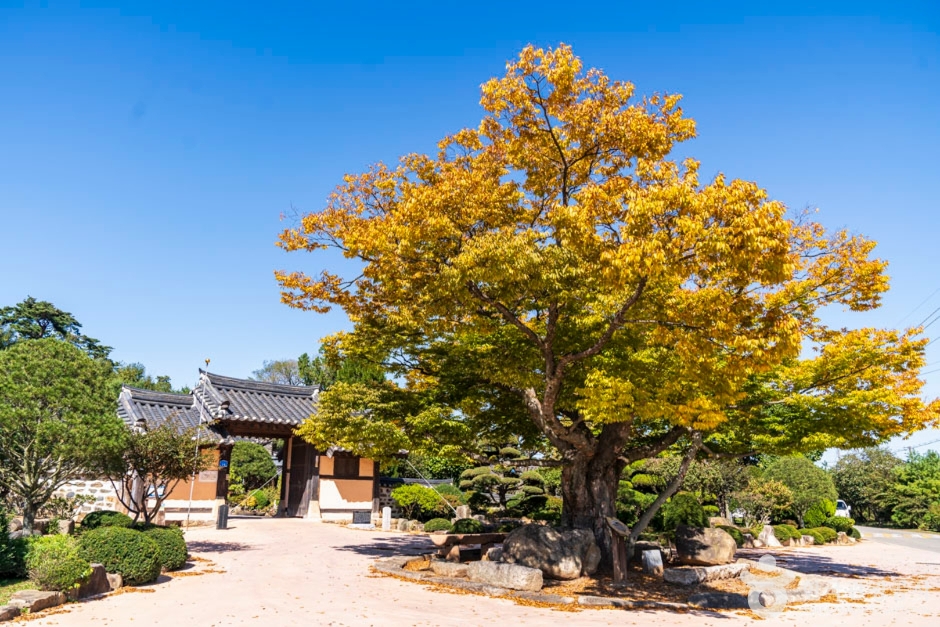
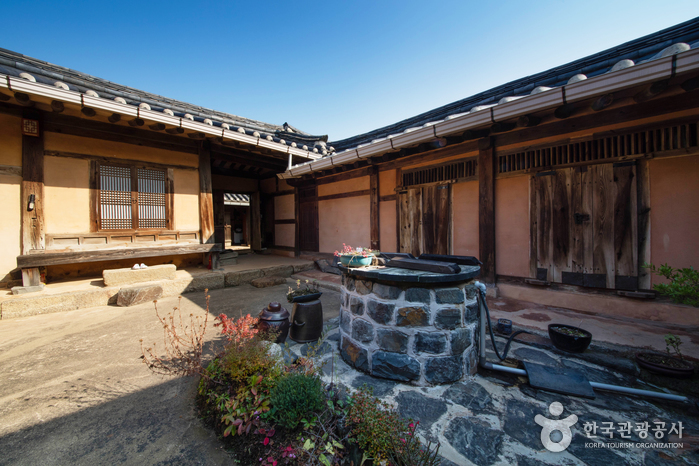
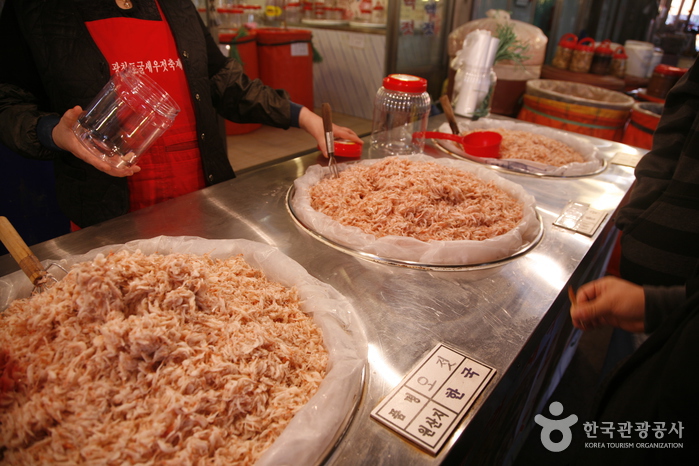
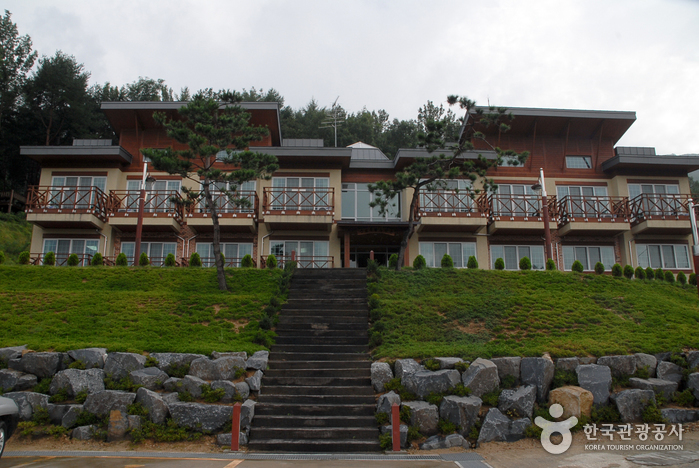
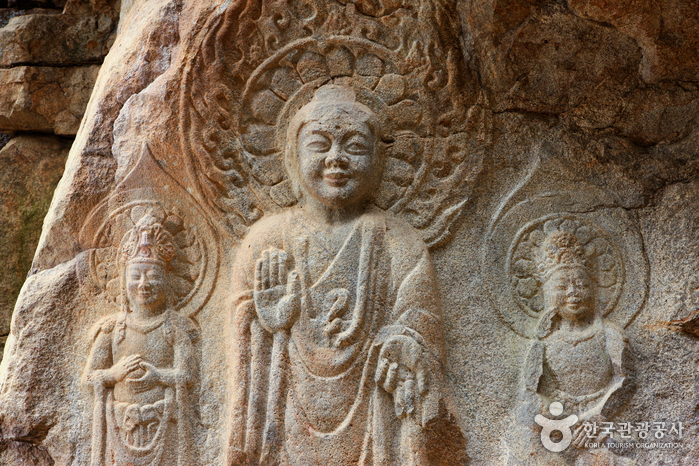
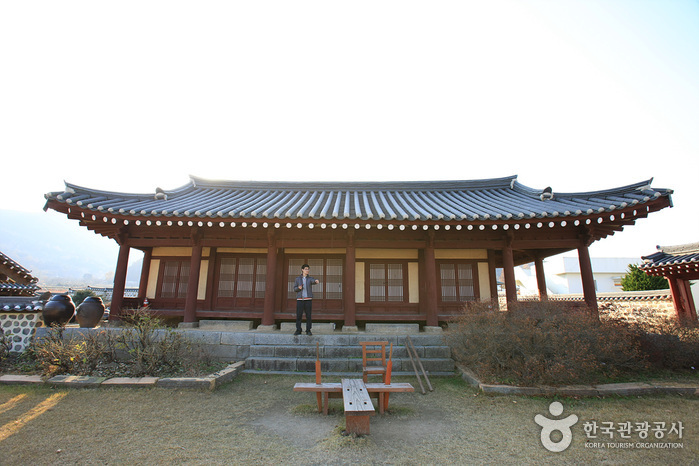
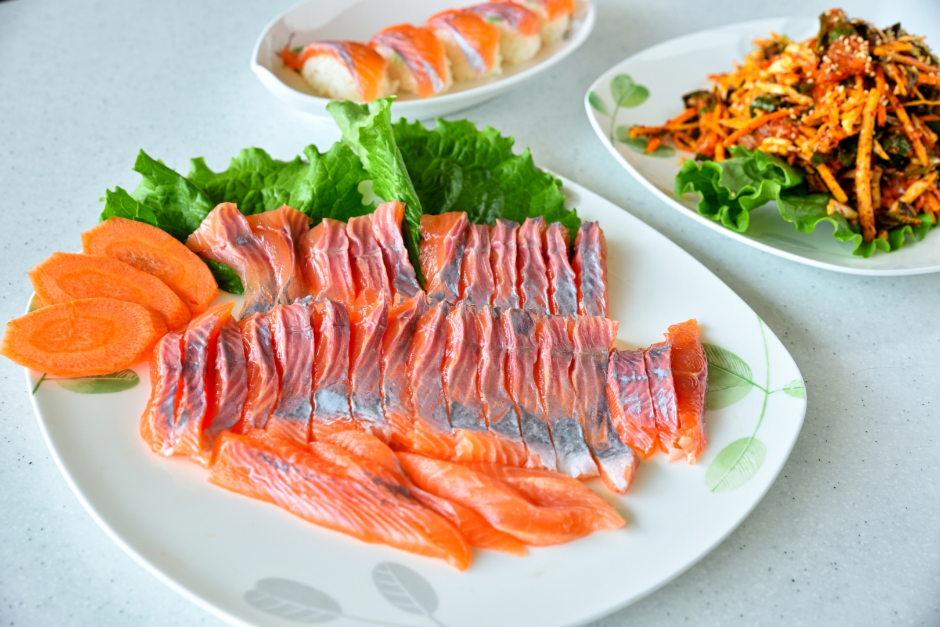
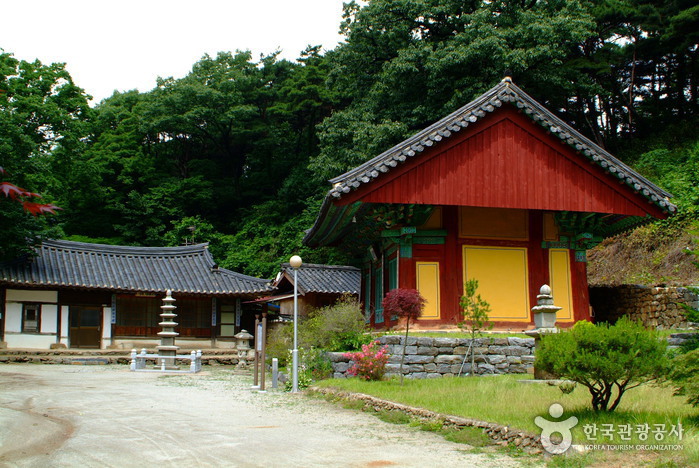
 English
English
 한국어
한국어 日本語
日本語 中文(简体)
中文(简体) Deutsch
Deutsch Français
Français Español
Español Русский
Русский